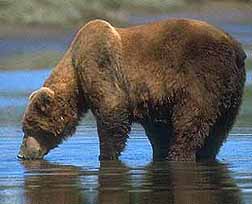 |
 The
Green Lane The
Green Lane Search
The Green Lane Search
The Green Lane
 Home Home Français
Français Partners
Partners Glossary
Glossary
 Search
Species at Risk Search
Species at Risk |
 |
 The
Green Lane The
Green Lane Search
The Green Lane Search
The Green Lane
 Home Home Français
Français Partners
Partners Glossary
Glossary
 Search
Species at Risk Search
Species at Risk |
| Grizzly Bear
Prairie population |
|
|
|
|
| Latin name: | Ursus arctos |
| Taxonomic group: | Mammals |
| Risk category: | Extirpated |
| Range: | AB MB SK |
| Year of designation: | 1991 |

| Description:
The Grizzly Bear is larger than the Black Bear. It has a characteristic hump on the shoulders and long fur that ranges in color from a creamy yellow to black, usually with some white-tipped hairs around the face and on the shoulders that give it a grizzled appearance. The thick winter underfur is rubbed off in the late spring. |
|
| Biology:
Grizzlies reach sexual maturity at 5 to 8 years of age. Females breed every 2 to 4 years. The gestation period is between 229 and 266 days. Litters range from 1 to 4 cubs, but two cubs are usual. |
|
|
Population and Distribution: Approximately 80% of Canadian grizzlies are found in British Columbia and the Yukon; the remainder of the population is found in Alberta and the Northwest Territories. The Grizzly Bear has been completed extirpated from the Prairie provinces, where it was hunted to extermination. Estimates indicate that the Canadian population may be composed of up to 20,000 bears. |
|
| Habitat:
Grizzlies inhabit a variety of terrains including coastal rain forests, alpine and arctic tundras, boreal forests and subalpine forests. The requirements for suitable grizzly habitat include: an adequate food supply; appropriate denning sites; the presence of some type of cover; and isolation from human disturbance. |
|
| Threats:
The major cause of the decline of grizzly populations has been human predation. Disturbances caused by humans can limit reproductive success and cause death. These disturbances include improper garbage disposal, increased use of the back country, camps located near denning areas, increased use of low-level aircraft, increased use of roads located in bear country, and increased number of people in bear habitats. |
|
| Protection:
Grizzly Bears are hunted as trophy animals. Quotas, licenses and other regulations are beginning to be applied to this hunt. It is legal for anyone to kill Grizzly Bears in defense of property, and native people can kill these bears for food. Grizzlies are completely protected in National Parks, but this protection applies to less than 8 % of the Canadian population of grizzlies. |
|
| Recovery efforts:
Approximately 80% of Canadian grizzlies are found in British Columbia and the Yukon; the remainder of the population is found in western Alberta and the Northwest Territories. The grizzly bear has been completely extirpated from the Prairie provinces, where it declined due to loss of habitat and prey (the American bison) and then was hunted to extermination. In 1991, the species was designated "extirpated" in the prairie provinces and "vulnerable" in the remainder of the species' range, where an estimated 20,000 bears still live. Reintroduction of the grizzly to the prairies is not a realistic option, since neither habitat nor prey are sufficient to sustain a viable prairie population, so recovery efforts are directed at conserving the species and its habitat in the remainder of its range. |
|
|
||
 The Green Lane
The Green Lane CWS Home
CWS Home Home
Home Français
Français
 Glossary Glossary Partners
Partners Search The
Green Lane
Search The
Green Lane
 Search
Species at Risk Search
Species at Risk |
||
 |
Comments
to: National Coordinator, Marketing and Outreach
Endangered Species Conservation Last update: 07/10/1999 URL of this page: http://www.speciesatrisk.gc.ca/Species/English/SearchDetail.cfm Use of photos Copyright © 1999, Environment Canada. All rights reserved. |
|
| You are on the CWS Web site, part of The Green Lane TM, Environment Canada's Internet site. | ||